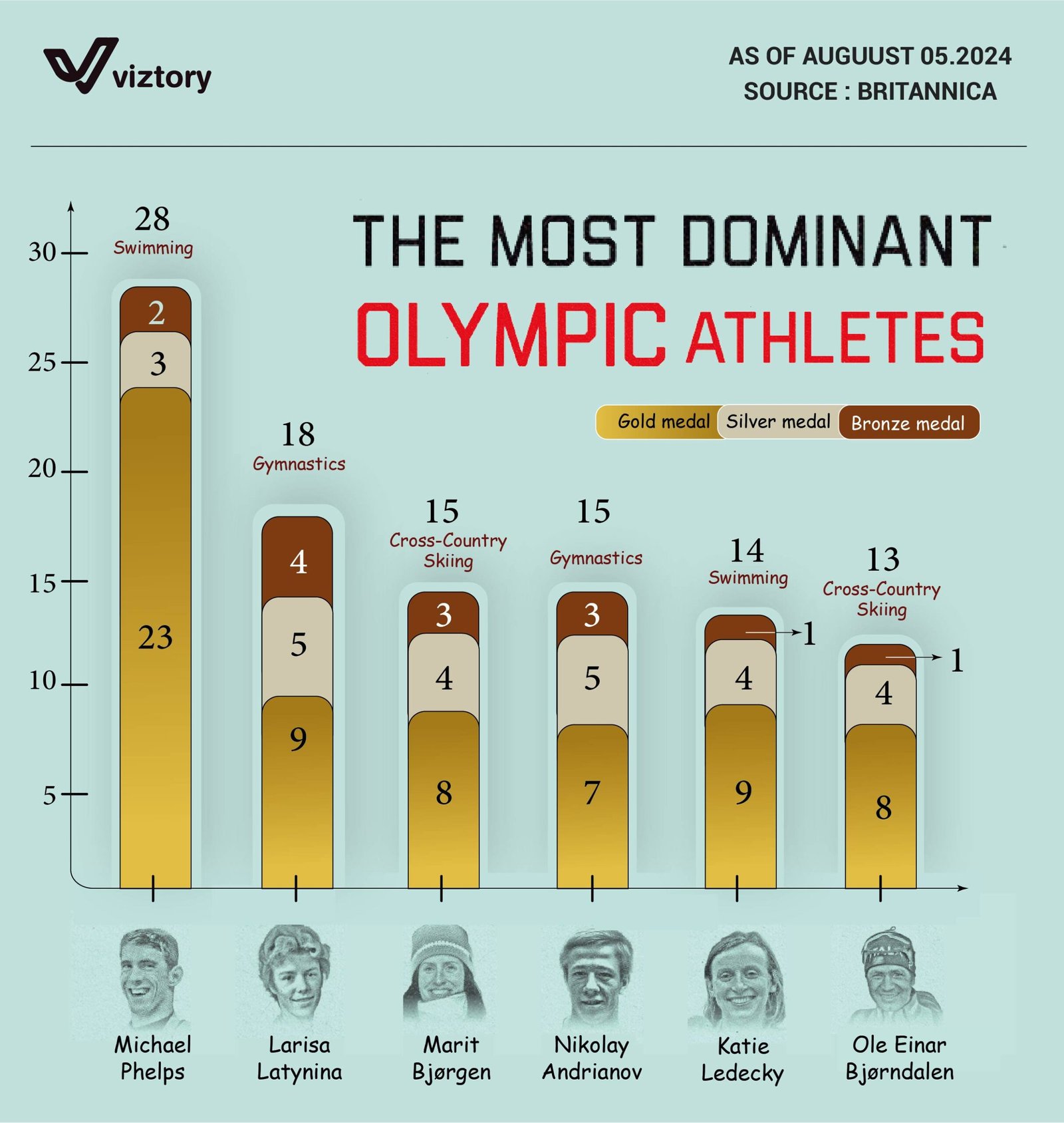The Importance of Sports and Healthcare: Lessons from the Most Dominant Olympic Athletes
-
Aug, Sat, 2024
The Importance of Sports and Healthcare: Lessons from the Most Dominant Olympic Athletes
The image illustrates the most dominant Olympic athletes as of August 5, 2024, highlighting their incredible achievements in various sports. These athletes, including legends like Michael Phelps, Larisa Latynina, and Katie Ledecky, have set unparalleled records in their respective disciplines. Their success stories serve as powerful reminders of the importance of sports and physical activity in promoting health and well-being.
The Legacy of Dominant Olympians
Michael Phelps: With an astounding 28 Olympic medals, including 23 golds, Phelps is widely regarded as the greatest swimmer of all time. His achievements are a testament to dedication, rigorous training, and a deep understanding of the science of swimming.
Larisa Latynina: The Soviet gymnast with 18 Olympic medals, including 9 golds, dominated the gymnastics scene during the 1950s and 1960s. Her success underscored the importance of flexibility, strength, and precision in gymnastics.
Marit Bjørgen and Ole Einar Bjørndalen: These cross-country skiers from Norway have a combined total of 28 Olympic medals. Their stamina and endurance are exceptional, showing the critical role of cardiovascular fitness in winter sports.
Katie Ledecky: An American swimmer, Ledecky has won 14 Olympic medals, with 10 being gold. Her dominance in long-distance freestyle events highlights the importance of mental toughness and consistent training.
The Role of Sports in Promoting Health
Engaging in regular physical activity, whether at an elite level like these Olympians or just as part of daily life, has numerous health benefits:
Physical Fitness: Regular exercise improves cardiovascular health, strengthens muscles, and enhances flexibility. It also helps in maintaining a healthy weight, reducing the risk of obesity-related diseases such as diabetes and hypertension.
Mental Health: Physical activity is known to release endorphins, which can reduce stress, anxiety, and depression. Sports also promote mental resilience and a sense of achievement, which are essential for overall well-being.
Longevity: Studies have shown that regular exercise can increase life expectancy by reducing the risk of chronic diseases. Athletes like those depicted in the image often lead long, healthy lives due to their active lifestyles.
Community and Social Interaction: Sports often foster a sense of community and belonging. Participating in team sports or group exercises can improve social connections, which is an essential component of mental health.
Integrating Sports into Healthcare
Given the profound impact of sports on health, it is crucial to integrate regular physical activity into healthcare routines. Healthcare providers should encourage patients to incorporate exercise into their daily lives, regardless of age or fitness level.
Personalized Exercise Plans: Healthcare professionals can develop personalized exercise plans that cater to individual needs and health conditions, ensuring that patients engage in safe and effective physical activity.
Promoting Active Lifestyles: Communities should invest in sports facilities and programs that encourage active living. Schools, workplaces, and local governments can play a significant role in making physical activity more accessible to everyone.
Education and Awareness: Public health campaigns should emphasize the benefits of regular exercise and how it can prevent chronic diseases. Educating people on the importance of sports can lead to healthier communities.
Conclusion
The remarkable achievements of the most dominant Olympic athletes demonstrate the extraordinary potential of the human body when nurtured through discipline, training, and a commitment to excellence. By integrating sports into healthcare, we can harness these benefits to improve public health, enhance quality of life, and create a healthier, more active society. Whether one aspires to be an Olympian or simply wishes to stay healthy, regular physical activity is a vital component of a balanced life.

